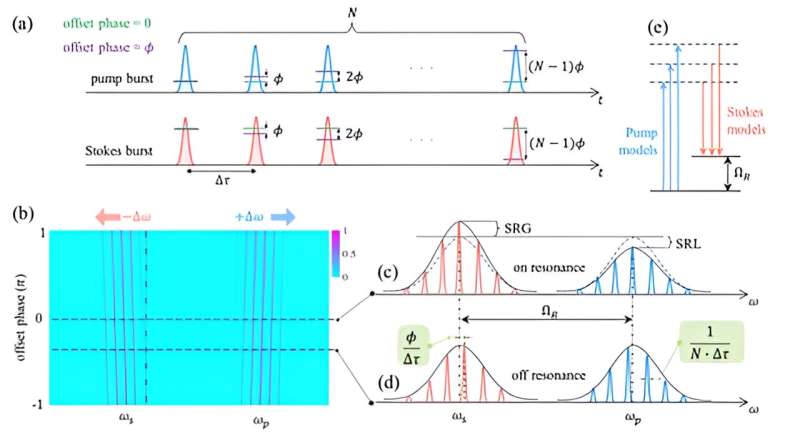This article has been reviewed according to Science X's editorial process and policies. Editors have highlighted the following attributes while ensuring the content's credibility:
fact-checked
peer-reviewed publication
proofread
Hyper-spectral-resolution stimulated Raman spectroscopy with amplified fs pulse bursts

Stimulated Raman scattering, observed first in 1962, has become a versatile tool in diverse fields such as biological imaging, environmental gas sensing, materials characterization, and molecular dynamics tracking. The choice of laser sources for exciting molecules or materials is critical, as it determines spectral resolution and the approach to obtain the Raman spectrum.
Traditional techniques for high-spectral-resolution stimulated Raman scattering spectroscopy involve scanning the spectrum step-by-step with narrowband laser pulses, limiting acquisition speed due to mechanical or thermal inertia. In contrast, parallel multi-wavelength probing with a narrowband picosecond excitation pulse and broadband femtosecond probe pulse introduces suboptimal temporal pulse overlap, presenting challenges such as suppressing non-resonant four-wave mixing background signals.
In a recent publication in Light: Science & Applications, a team of scientists, led by Prof. Andrius Baltuška from Photonics Institute at the TU Wien, Austria, and Dr. Xinhua Xie from SwissFEL at Paul Scherrer Institute, Switzerland, in collaboration with Prof. Alexei Zheltikov from the Department of Physics and Astronomy at Texas A&M University, U.S., introduce an innovative approach to stimulated Raman scattering spectroscopy.
They utilize amplified and offset-phase controlled femtosecond-pulse bursts to achieve hyper spectral resolution and high-speed spectral acquisition. Validated by solving the coupled non-linear Schrödinger equations and numerical characterization in molecular nitrogen, this technique offers high spectral resolution and motion-free scanning.
With its potential applications in gas sensing, chemical analysis, environmental pollution detection, isotope characterization, and molecular dynamics tracking, this stimulated Raman scattering method represents a significant leap forward in spectroscopic capabilities.
The first author of the publication, Dr. Hongtao Hu from Photonics Institute at the TU Wien, stated, "The amplified femtosecond-pulse burst needed for this method, as previously reported from our group, can be generated in a master oscillator and then amplified through a regenerative amplifier operated in a special mode."
In Figure 1 (a), the temporal shapes of the signal and idler bursts after the amplifier are depicted, marked as pump burst and Stokes burst, respectively, in the stimulated Raman scattering process. The inter-pulse temporal separation can be controlled by the cavity length difference between the regenerative amplifier and master oscillator roundtrips. The offset phase denoting to the phase difference between two neighboring pulses in the burst is manipulated by an acousto-optic modulator placed between the master oscillator and the regenerative amplifier.
In a well-designed optical parametric amplifier, the phases of the signal and idler pulses can be conjugated. Thus, by precisely manipulating the phase of the fundamental laser burst entering the optical parametric amplifier, the spectral modes elegantly shift in opposite directions of the signal and idler pseudo-combs, illustrated in Figure 1 (b).
As a result, the on- and off-resonant stimulated Raman scattering conditions, depicted in Figure 1 (c) and (d), can be simultaneously satisfied or missed by multiple pseudo-modes, contingent on the input phase of the pulses loaded into the regenerative amplifier.
Under resonant offset phases, pulse energy effectively transitions from the pump burst to the Stokes burst, inducing their respective loss and gain. This intricate procedure represents the essence of motion-free scanning, which is the key for achieving the Raman spectrum and the foundational principle of this innovative work.
Their numerical results, on the one hand, unveil the relation between spectral resolution and burst duration; the spectral resolution is inversely proportional to the product of burst duration and the number of pulses in the burst. For instance, achieving a spectral resolution of 0.17 cm-1 becomes feasible with a burst of 100 pulses and a burst duration of 2 picoseconds.
Furthermore, the results elucidate the growth pattern associated with the increasing number of pulses in the burst—a combination of linear and quadratic growth—ensuring a high signal-to-noise ratio for the Raman spectrum.
The novel approach in stimulated Raman scattering showcased in this work promises applications in gas sensing, chemical analysis, and molecular dynamics tracking. The innovative use of amplified and offset-phase controlled femtosecond-pulse bursts ensures hyper-spectral resolution and rapid spectral acquisition. This advancement not only signifies a significant leap in spectroscopic capabilities but also sparks anticipation for the transformative impact it could have on various scientific disciplines.
More information: Hongtao Hu et al, Hyper spectral resolution stimulated Raman spectroscopy with amplified fs pulse bursts, Light: Science & Applications (2024). DOI: 10.1038/s41377-023-01367-0
Journal information: Light: Science & Applications
Provided by TranSpread





















